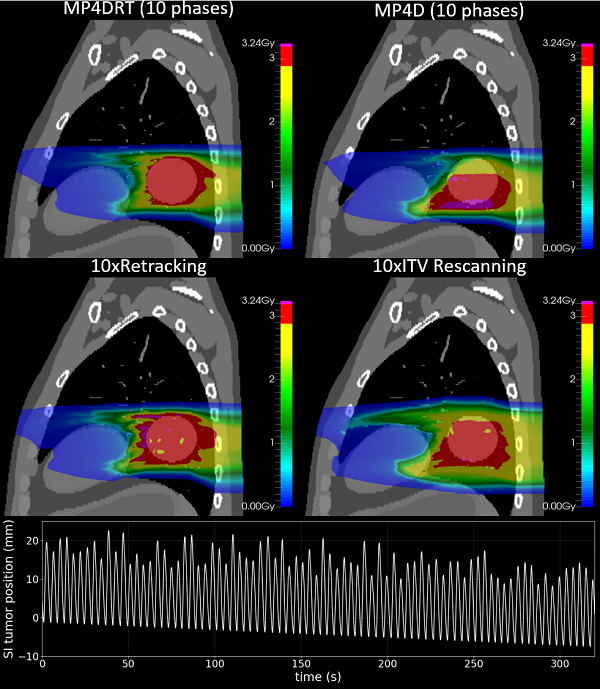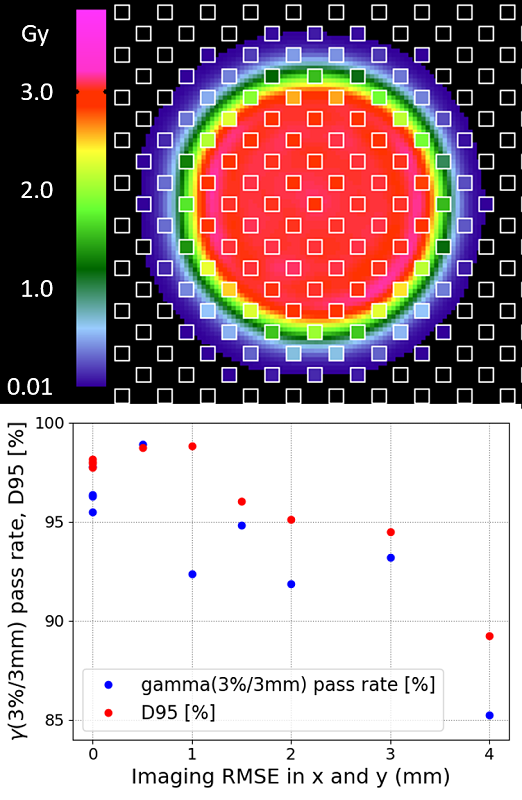Experimental demonstration of conformal carbon ion therapy for irregularly moving tumors
Timo Steinsberger,
Germany
PD-0238
Abstract
Experimental demonstration of conformal carbon ion therapy for irregularly moving tumors
Authors: Timo Steinsberger1,2, Marco Donetti3, Michelle Lis1,4, Lennart Volz1, Moritz Wolf1, Marco Durante1,2, Christian Graeff1,5
1GSI Helmholtzzentrum für Schwerionenforschung, Biophysics Department, Darmstadt, Germany; 2Technical University of Darmstadt, Institute for Condensed Matter Physics, Darmstadt, Germany; 3Fondazione CNAO, Research Department, Pavia, Italy; 4Louisiana State University, Department of Physics and Astronomy, Baton Rouge, USA; 5Technical University of Darmstadt, Department of Electrical Engineering and Information Technology, Darmstadt, Germany
Show Affiliations
Hide Affiliations
Purpose or Objective
Treatment of locally advanced NSCLC is limited by toxicity and insufficient local control. Particle therapy could enable more conformal treatment than photon IMRT, but is challenged by irregular tumor motion, associated range changes and tumor deformations. Therefore, we propose a new strategy for robust online adaptive carbon ion therapy, which synergizes 4D treatment planning with online adaptive tumor tracking. The strategy was tested at a clinical carbon ion facility. We hypothesize that the technique is robust against irregular motion and limited motion imaging errors.
Material and Methods
In multiphase 4D synchronized deliveries (MP4D), a separate conformal quasi-static treatment plan is created for each motion phase of a periodic 4DCT. During delivery, the motion phase is detected. For each energy slice, the dose delivery system (DDS) switches without delay between phase plans until all phase plans are completed. In the new method ‘MP4D with residual tracking’ (MP4DRT), the displacement of the tumor center-of-mass with respect to the same phase in the planning CT is compensated for by lateral beam tracking. We implemented this method into the DDS of CNAO and tested it experimentally for a patient plan based on a periodic 10 phase subset of a virtual XCAT 4DCT (planned motion amplitude 20mm). Treatments were delivered in a QA-like setting to a moving IC array. Log-file based dose reconstructions were performed on the full non-periodic XCAT 4DCT. MP4DRT was compared to MP4D, tracking and ITV plans. Tracking and ITV plans were rescanned 10x.We considered variable motion amplitudes and baseline drifts. The required precision of tumor imaging was evaluated by adding noise and latency to the motion signal.
Results
The table shows target coverage (D95), homogeneity (D5-D95) and conformity (CN) for deliveries with 25% amplitude variation +/- baseline drift of up to 8mm.
Mode
| MP4DRT
|
| MP4D |
| Tracking
|
| ITV
|
|
Baseline
| stable
| drift
| stable | drift | stable | drift | stable | drift |
D95 [%]
| 98.0
| 98.2
| 96.8
| 69.3
| 94.0
| 95.0
| 95.5
| 89.3
|
D5-D95 [%]
| 5.8
| 6.3
| 7.9
| 37.2
| 11.2
| 10.4
| 7.1
| 12.6
|
CN [%]
| 61.5
| 61.5
| 62.6
| 30.7
| 43.2
| 43.2
| 45.8
| 16.1
|
Fig. 1 shows dose distributions delivered for an irregular motion scenario with baseline drift. Fig. 2 compares measurements to planned dose distributions. The impact of imaging errors is shown by gamma pass rate and D95 on the CT reconstruction, where errors up to 2 mm led to clinically acceptable results.

Figure 1: Reconstructed doses for the depicted motion trace with amplitude variation and baseline drift. Only MP4DRT fully restores target coverage.

Figure 2: Top: Overlay of planned doses (background) and measurement of the IC array (small squares) for MP4DRT. Bottom: Dependence of gamma (3%/3mm) pass rate between planned and measured dose distribution and of target D95 on the noise added to the motion signal for MP4DRT.
Conclusion
We showed in a clinical setting that MP4DRT is able to deliver highly conformal and homogeneous dose distributions to irregularly moving targets, even in the presence of clinically relevant imaging errors.